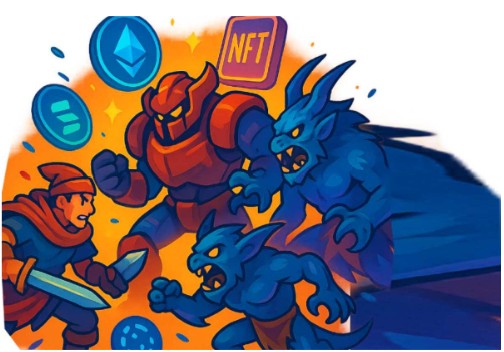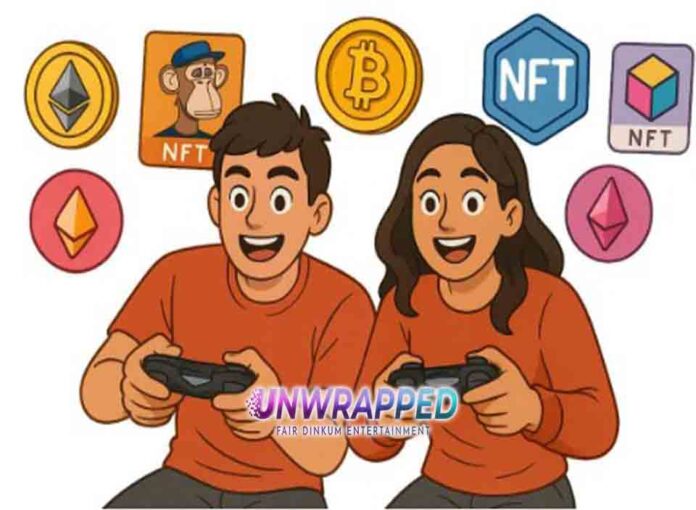NFTs have introduced a revolutionary way for players to own, trade, and earn from in-game assets. However, the crux of successful NFT game monetization lies in seamlessly integrating these assets into the game’s economy without disrupting the core gameplay experience. This involves understanding the dynamics of both traditional and play-to-earn games and how NFTs can enhance rather than detract from the player experience.
What is NFT Game Development?
NFT game development refers to the process of creating video games that utilize non-fungible tokens (NFTs) as part of their core mechanics. Unlike traditional game assets, which are often server-based and can be altered or deleted by developers, NFTs are unique digital tokens stored on a blockchain. This allows players to have true ownership of their in-game assets, such as characters, skins, weapons, or even virtual land.
The development of NFT games requires a multi-faceted approach that involves various disciplines, including blockchain technology, game design, and community engagement. Developers must be well-versed in programming smart contracts—self-executing contracts with the terms of the agreement directly written into code—ensuring that NFTs can be created, bought, sold, and traded within the game environment seamlessly.
Furthermore, NFT Games Development necessitates a deep understanding of player incentives, as the value of NFTs can fluctuate based on demand and supply dynamics. Developers must establish engaging gameplay loops that encourage players to earn, trade, and utilize NFTs while simultaneously balancing the in-game economy to prevent inflation and uphold fair play.
In summary, NFT gaming creation is an innovative and rapidly evolving field that combines traditional game design principles with cutting-edge blockchain technology. By enabling true ownership of digital assets, developers can create unique and engaging gaming experiences that resonate with players and capitalize on the growing interest in cryptocurrencies and NFTs.
The Core of Game Monetization Strategies
Traditional game monetization has relied heavily on models such as in-app purchases, ads, subscriptions, and premium content. These models have provided a steady revenue stream, allowing developers to support ongoing game development and maintenance. However, they often face criticism for creating barriers that can hinder player enjoyment, such as intrusive ads or paywalls.
With the rise of blockchain game development with NFTs, the focus shifts towards creating real-world value from in-game activities through the unique properties of NFTs. This new approach enables players not only to enjoy the game but also to earn tangible benefits—a concept gaining momentum through the play-to-earn model. By integrating NFTs into blockchain-based ecosystems, developers can redefine traditional monetization strategies, offering players ownership of digital assets that may appreciate in value over time.
The Play-to-Earn Phenomenon
Play-to-earn games have redefined the gaming landscape by rewarding players with cryptocurrency or NFTs for their in-game achievements. This model not only incentivizes gameplay but also democratizes earning potential, allowing players from all walks of life to benefit from their gaming prowess. It transforms gaming from a purely recreational activity into a viable income stream, especially in regions where economic opportunities are limited.
Implementing this model requires careful consideration to ensure that it remains fair and accessible to all players. Developers must design systems that reward genuine skill and effort, avoiding scenarios where players with deeper pockets can simply buy their way to success. Additionally, providing educational resources on managing and trading NFTs can empower players to make informed decisions, enhancing their gaming experience.
Integrating NFTs into Traditional Game Models
Integrating NFTs into traditional game models involves more than merely adding a blockchain layer. It requires a deep understanding of player motivations and how NFTs can complement existing mechanics. Developers should aim to create a seamless transition where NFTs feel like a natural extension of the game, enriching the experience rather than overshadowing it.
This can be achieved by aligning NFTs with the game’s core themes and mechanics, offering players unique opportunities to enhance their gameplay. For instance, NFTs could represent special abilities, rare items, or exclusive content that players can unlock through skillful play. By integrating NFTs thoughtfully, developers can enhance player engagement and loyalty, creating a more immersive and rewarding experience.
Crafting an Engaging NFT Experience

Creating an engaging NFT experience demands more than just integrating blockchain technology into a game. It requires a nuanced understanding of player motivations and how they interact with game narratives and mechanics.
Building Player Trust
Trust is a cornerstone of successful NFT game monetization. Players need to feel confident that their investments in NFTs are secure and that the game developers are transparent about how these assets are managed. Transparency in NFT issuance and management is crucial, as players want assurance that their assets will retain value and not be subject to arbitrary changes.
This involves providing clear communication about NFT value, scarcity, and utility within the game world. Developers should establish clear guidelines on how NFTs are created, distributed, and utilized within the game ecosystem. Regular updates and open communication channels can help build trust, ensuring players feel valued and respected.
Balancing Game Economy
A balanced game economy is vital to prevent inflation or deflation of NFT values. Developers must ensure that the introduction of NFTs does not disrupt in-game economies or create disparities among players. This involves setting appropriate limits on NFT issuance and ensuring that they complement, rather than overshadow, traditional gameplay elements.
Developers should carefully monitor the supply and demand of NFTs, making adjustments as needed to maintain economic stability. They can introduce mechanisms to control inflation, such as token burning or limited-time releases, ensuring that NFTs remain valuable and desirable. By maintaining a balanced economy, developers can create a sustainable ecosystem that benefits all players.
Enhancing Storylines with NFTs
NFTs can enrich game narratives by offering unique story elements or exclusive content tied to specific tokens. This not only enhances player engagement but also adds layers of depth to the game world. Developers should leverage their understanding of intricate storylines to integrate NFTs in a way that enriches the overall player experience.
For example, NFTs could unlock hidden story arcs, special characters, or alternate endings, providing players with new ways to explore the game world. By tying NFTs to meaningful narrative elements, developers can create a more immersive experience that resonates with players emotionally. This approach can deepen player investment in the game, fostering a stronger connection to the narrative and its characters.
Avoiding Common Pitfalls in NFT Game Monetization
While the potential of NFTs in gaming is vast, there are common pitfalls developers must avoid preventing player alienation.
Over-Monetization
Excessive focus on monetization can detract from gameplay and lead to a perception of greed. Developers should avoid placing monetization above player enjoyment by ensuring that NFTs are optional and do not create a “pay-to-win” environment. Players should feel that their success in the game is determined by skill and strategy, not by their willingness to spend money.
To avoid over-monetization, developers can offer a balanced mix of free and paid content, ensuring that players who choose not to spend money can still enjoy a fulfilling game experience. Offering cosmetic or vanity NFTs that do not impact gameplay can also provide a monetization avenue that does not alienate players. By prioritizing player enjoyment over profit, developers can cultivate a loyal and engaged player base.
Lack of Accessibility
Ensuring that NFT games remain accessible to a broad audience is crucial. High entry costs or complex onboarding processes can deter potential players. Developers should strive to create inclusive games where NFTs enhance, rather than restrict, player participation.
To achieve this, developers can offer free or low-cost entry points, allowing players to experience the game without financial barriers. Simplifying the onboarding process and providing clear instructions can also help new players acclimate to the game’s mechanics and NFT features. By prioritizing accessibility, developers can attract a diverse player base, fostering a more vibrant and inclusive community.
Ignoring Community Feedback
The gaming community is an invaluable resource for insights into player preferences and concerns. Developers should actively engage with their community, soliciting feedback and making adjustments based on player input to foster a loyal and satisfied player base. By listening to players, developers can identify areas for improvement and make informed decisions that enhance the gaming experience.
Developers can utilize forums, social media, and in-game surveys to gather feedback, ensuring that they remain attuned to player sentiments. Regularly updating players on development progress and addressing their concerns can build trust and strengthen the community. By valuing player feedback, developers can create a game that resonates with its audience, fostering long-term engagement and success.
Successful Examples of NFT Game Monetization
Several games have successfully navigated the intricacies of NFT monetization while maintaining player satisfaction. One such example is “Axie Infinity,” a game that has pioneered the play-to-earn model by allowing players to earn cryptocurrency through gameplay. “Axie Infinity” has built a thriving community by offering players real ownership of their in-game assets, creating a robust and dynamic economy.
Another example is “The Sandbox,” which empowers players to create and monetize their own game experiences using NFTs. “The Sandbox” offers a unique platform where players can express their creativity, building and sharing their virtual worlds with others. By providing tools for content creation and monetization, “The Sandbox” has cultivated a vibrant ecosystem that encourages player innovation and collaboration.
Conclusion: Striking the Perfect Balance
Successfully monetizing NFT games without alienating players requires a careful and nuanced approach. By understanding the dynamics of game monetization strategies, integrating NFTs thoughtfully, and actively engaging with the gaming community, developers can create compelling experiences that satisfy both their business objectives and the desires of their players.
Ultimately, the goal is to use NFTs to enhance the gaming experience, creating a symbiotic relationship between players and developers. As NFTs continue to evolve, so too must the strategies employed to harness their potential in the world of gaming. By fostering trust, ensuring accessibility, and valuing community feedback, developers can navigate the complexities of NFT game monetization and emerge with a thriving, engaged player base.
The journey to successful NFT game monetization is an ongoing process that requires adaptability and innovation. Developers who remain committed to understanding player needs and evolving market trends will be well-positioned to capitalize on the opportunities that NFTs present. By striking the perfect balance, developers can create games that not only achieve financial success but also resonate with players on a deeper level.









